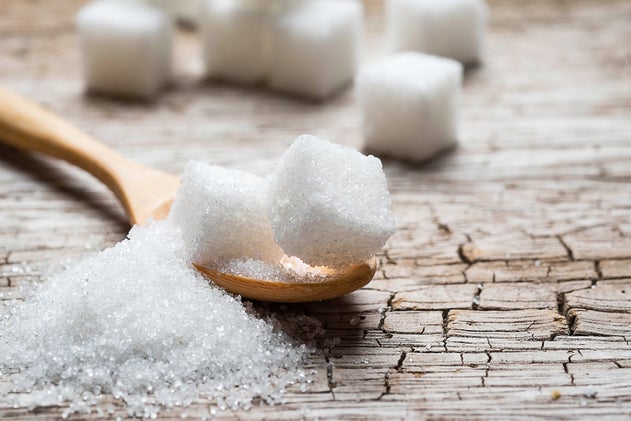Sugar, Sugar and more Sugar!
10 Top Strategies To Break Your Sugar Habit
Nutrition By Matthew Kadey, M.S., R.D.Updated On: Jan 3, 2017
 Photo: Shutterstock.com
Photo: Shutterstock.com
Life is sweet, all right—so sweet that the average American now eats about 129 pounds of caloric sweeteners each year, according to the U.S. Department of Agriculture. While a dedicated triathlete can get away with consuming a bit more sugar than a couch potato, it’s still a good idea to limit intake for overall better health and performance; a diet high in the sweet stuff is linked to everything from weight gain to diabetes to recovery-impairing inflammation. Plus, high-sugar foods may crowd out other more nutritious options that can better fuel workouts and help repair muscles. But the ubiquitousness of added sweeteners hidden in our food supply can make it a challenge to scale back. Presenting 10 tactics to make your diet a little less saccharine.
Read the fine print
About 75 percent of packaged foods on store shelves contain sweeteners, a 2012 study in the Journal of the Academy of Nutrition and Dietetics reveals. Added sugar can sneak into foods you might not expect to have it, such as peanut butter, bread and tomato sauce.
Know the lingo
By 2018, all food companies must list the grams of added sugar in their products on packaging. Until then, learn to recognize the many euphemisms for sugar that can populate ingredient lists, and avoid purchasing products that list them. These double agents can include maltodextrin, fruit juice concentrate, barley malt, dextrose and maltose.
Tame the gels
From bars to gels to sports drinks, sports nutrition products often contain a lot of sugar. While the quick energy can help power your workouts, it won’t do much to help your waistline if consumed too liberally. Stick with using these products only during long workouts (more than 90 minutes) and opt for whole foods over packaged products during the rest of the day.
Timing counts
If you’re prone to sugar cravings, the best time to satisfy one is just after a calorie-crushing workout. In the moments after vigorous exercise, your muscles are itching for sugar to help replace spent glycogen stores, the main source of energy for high-intensity exercise. You still don’t want to go overboard, but if you’re going to give into cookie temptation, this is the ideal time to do it.
Scale back
When baking batches of muffins and cakes, keep in mind that many recipes call for more sugar than what is necessary. So unless a dessert-style recipe is written specifically to be lower in sugar, try simply reducing the amount of sweetener called for by 25 percent or more. Most often, you need not adjust any other ingredients.
Go natural
Embrace foods that are naturally sweet. Sugars in vegetables and fruits like beets, sweet potatoes and apples don’t count as added sugars, and research is bereft of any data linking natural-occurring sugars to health woes. That’s because the sugar in whole foods is bundled with other key nutrients, including vitamins, minerals, antioxidants and hunger-crushing fiber. So buy plain versions of items like yogurt and oatmeal, then sweeten them naturally with berries. Unsweetened dried fruit including apricots and figs can help you kick those candy cravings, but they are more concentrated in sugar than their fresh counterparts, so moderate your intake.
Work up a sweat
A recent Austrian study found that when people exercise for just 15 minutes, their urge for sugary snacks dropped by 23 percent. Exercise releases feel-good endorphins, giving you the same rush that a sugary treat would.
Embrace other tastes
Sweetness is just one of the five main tastes. The others: salty, sour, bitter and umami. You can recalibrate your palate to prefer other tastes by gradually increasing your intake of unsweetened sour (such as plain yogurt or tart cherries), bitter (arugula and radicchio) and savory umami (miso and mushrooms) foods. Once you break the sugar cycle, you might find you prefer your morning coffee plain.
Spice is nice
Amp up the flavor in your meals and snacks like oatmeal and yogurt with warming spices such as cinnamon, cloves and nutmeg. They’ll excite your taste buds and provide some healthful antioxidants to boot.
Avoid zero-calorie sweets
Calorie-free sweeteners may not help you tame a sweet tooth. It’s thought they activate reward centers in the brain and disrupt appetite control, leading to increased overall sugar cravings and food intake. Also, if you drink a diet soda or munch on sugar-free cookies, you might be more likely to give yourself permission to splurge on a bigger slice of cake or scoop of ice cream later on. For these reasons, studies have generally found less than impressive results with respect to calorie-free sweeteners and weight loss.
Read more at http://www.triathlete.com/2017/01/nutrition/10-top-strategies-break-sugar-habit_297238#VCv8rcJ3t4A7BuIh.99
 mx43 | Posted on
mx43 | Posted on  Tuesday, January 3, 2017 at 9:40PM |
Tuesday, January 3, 2017 at 9:40PM |  Post a Comment |
Post a Comment |  Share Article |
Share Article |  Email Article
Email Article 









Reader Comments